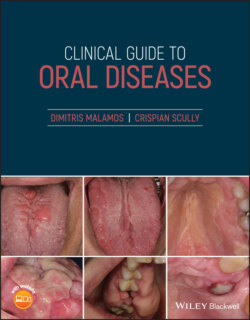Читать книгу Clinical Guide to Oral Diseases - Crispian Scully - Страница 31
Case 2.6
ОглавлениеFigure 2.6
CO: A 67‐year‐old woman was referred for evaluation of a bluish discoloration of her lips.
HPC: Her lips had a blue hue which was first noticed by her dentist during her routine dental examination one week ago.
PMH: She suffered from mild diabetes, chronic asthma and congestive heart failure and was under a special diet and treated with systemic steroids and salbutamol inhaler (in crisis) and furosemide and metoprol tablets. She was an ex‐smoker but never a drinker and had no history of facial trauma recently.
OE: The physical examination revealed an overweight lady with bluish discoloration of both her lips (Figure 2.6). Her lips were smooth, moist with no evidence of desquamation or atrophy but with a diffuse bluish discoloration that remained unchanged under pressure. No other similar lesions were found intra‐orally. The patient also complained about shortness of breath and tiredness, while her face was pale and her legs were swollen.
Q1What is the cause of her lip discoloration?
1 Hemangioma
2 Heart failure induced
3 Blue nevus
4 Hematoma
5 Melanoma
Answers:
1 No
2 Congestive heart failure is the cause of the bluish color of her lips (cyanosis), skin and other mucosae and appears when the level of deoxygenated hemoglobin level is above of 5 g/dl. Cyanosis is more obvious in an acute crisis of asthma.
3 No
4 No
5 No
Comments: In heart failure, the cyanosis is mixed (central and peripheral) and differs clinically from similar lesions such as hemangiomas, blue nevus, melanoma, or even hematomas. The stable blue color on the patient's lips regardless of its duration or absence of bleaching changes seen with local pressure exclude hematoma, hemangiomas, and blue nevus respectively. The fact, that her blue discoloration was diffuse, without over‐growths or satellite lesions or color variations equally found on both lips, rules out melanoma from diagnosis.
Q2 Cyanosis is more obvious in patients with:
1 Dark complexion
2 Vitamin C deficiencies
3 Anemia
4 Post‐inflammatory pigmentation
5 Bullous disorders
Answers:
1 No
2 Vitamin C deficiency causes scurvy, a condition that leads to abnormally pale skin and therefore the cyanosis is more obvious.
3 Anemia is characterized by cyanosis when the oxygen saturation falls below hemoglobin levels. Cyanosis appears when the oxygen saturation in patients without anemia drops to <80–85 per cent and even lower than 60 per cent in patients with severe anemia (Hb < 6 g/dl).
4 No
5 No
Comments: The blue color is the result of deoxyhemoglobin's optical properties and especially its porphyrin rings; therefore it is more difficult to be seen in patients with dark skin due to racial or post‐inflammatory pigmentation.
Q3 The differences between peripheral and central cyanosis are based on:
1 Location of cyanosis
2 Degree of cyanosis
3 Temperature of affected parts
4 Response to oxygen
5 Duration of cyanosis
Answers:
1 In central cyanosis the discoloration is generalized and affects the skin, oral and other mucosae while the peripheral cyanosis is localized only on the skin.
2 No
3 The limb temperature is unaffected in central, but is lower in peripheral cyanosis.
4 The application of pure oxygen improves the central but not peripheral cyanosis.
5 No
Comments: The duration of cyanosis reflects on the severity rather than the type of cyanosis. Cyanosis of a few seconds seems benign, while a prolonged or unresolved cyanosis may raise concerns of serious complications such as seen in heart, lungs, or brain.
